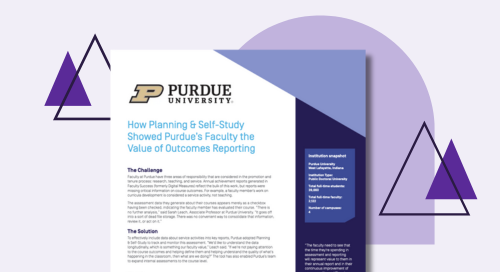Faculty at Purdue have three areas of responsibility that are considered in the promotion and tenure process: research, teaching, and service. Annual achievement reports generated in Faculty Success (formerly Digital Measures) reflect the bulk of this work, but reports were missing critical information on course outcomes. For example, a faculty member’s work on curricula development is considered a service activity, not teaching.
The assessment data they generate about their courses appears merely as a checkbox having been checked, indicating the faculty member has evaluated their course. “There is no further analysis,” said Sarah Leach, Associate Professor at Purdue University. “It goes off into a sort of dead file storage. There was no convenient way to consolidate that information, review it, or act on it.”


To effectively include data about service activities into key reports, Purdue adopted Planning & Self-Study to track and monitor this assessment. “We’d like to understand the data longitudinally, which is something our faculty value,” Leach said. “If we’re not paying attention to the course outcomes and helping define them and helping understand the quality of what’s happening in the classroom, then what are we doing?” The tool has also enabled Purdue’s team to expand internal assessments to the course level.
“The faculty need to see that the time they’re spending in assessment and reporting will represent value to them in their annual report and in their continuous improvement of course quality, and Planning & Self-Study makes that possible.”
Sarah Leach, Associate Professor, Purdue University
Leach shared the reporting possibilities with the faculty in spring 2021 and got widespread approval. “They liked the idea that we could map formative outcomes in lower-division courses building up towards our summative outcomes that we report externally (along with those we just personally care about),” Leach said.
Purdue introduced the system to the School of Engineering Technology in fall 2021, including 65 faculty, five programs, and eight locations. They’ll be using the data for their next Accreditation Board for Engineering and Technology review in three years.
Faculty are able to enter assessment data directly into Planning & Self-Study and use system reports to improve their day-to-day work. “We’ve helped everyone recognize the value we will get by being able to easily generate reports on the results of assessments and our formative-to-summative plan.”

See how our tools are helping clients right now, get in-depth information on topics that matter, and stay up-to-date on trends in higher ed.